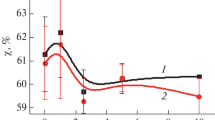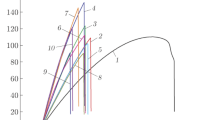The necessary composition and content of fillers of a multicomponent extrudable composition based on an ultrahigh-molecular polyethylene (UHMPE) with specified mechanical and tribotechnical characteristics are determined. For the purpose of effective and operational development of extrudable composites based on an UHMPE, a minimum amount of experimental data and an algorithm for determining the governing parameters (formulations) is used, which give the needed (restrictive) values for the effective characteristics of multicomponent polymer-polymer compositions. This allows one to secure the tribological, mechanical and technological properties required. The limited amount of experimental data for the relation between the effective properties and the formulation required is supplemented by values calculated using the Lagrange interpolation polynomial. The relations obtained are represented as surfaces and the corresponding level lines. The imposition of level lines allows one to determine the area that meets the requirements specified and to find the formulation necessary for it. On the basis of this algorithm, the optimum formulation of a three-component mixture consisting of an UHMPE, a high-density polyethylene grafted with maleic anhydride, and a polypropylene having tribomechanical properties at the level of an UHMPE, but with a melt flow-behavior index suitable for 3D printing by fused deposition modeling, is determined. According to the formulation found, samples were made and tested, and they completely satisfied the properties prescribed.



Similar content being viewed by others
References
S. M. Kurtz, UHMWPE Biomaterials Handbook, Amesterdam: Elsevier Science (2009).
G. E. Selytin, Yu. Yu. Gavrilov, E. N. Voskresenskaya, V. A. Zakharov, V. E. Nikitin, and V. A. Poluboyarov, “Composite materials on the basis of ultrahigh-molecular polyethylene: properties and prospects of employment,” Khimiya v Interes. Ustoich. Razv., 18, No. 3, 375-388 (2010).
E. M. Brach Del Prever, A. Bistolfi, P. Bracco, and С. Luigi, “UHMWPE for arthroplasty: past or future?” J. Orthop. Trauma, 10, No. 1, 1-8 (2009).
X. Wang, M. Jiang, Z. Zhou, J. Gou, and D. Huic, “3D printing of polymer matrix composites: A review and prospective,” Composites: Part B, 110, 442-458 (2017).
T. D. Ngo, A. Kashani, G. Imbalzano, K. T. Q. Nguyen, D. and Hui, “Additive manufacturing (3D printing): A review of materials, methods, applications and challenges,” Composites: Part B, 143, 172-196 (2018).
A. Gupta, G. Tripathi, D. Lahiri, and K. Balani, “Compression molded ultra high molecular weight polyethylenehydroxyapatite-aluminum oxide-carbon nanotube hybrid composites for hard tissue replacement,” J. Mater. Sci. Technol., 29, No. 6, 514-522 (2013).
N. Chang, A. M. Naik, and H. K. Khaira, “Development of UHMWPE modified PP/PET blends and their mechanical and abrasive wear behavior,” Polym. Compos., 5, 267-272 (2007).
R. A. Borges, D. Choudhury, and M. Zou, “3D printed PCU/UHMWPE polymer blend for artificial knee meniscus,” Tribol. Int., 122, 1-7 (2018).
M. S. Ramli, M. S. Wahab, M. Ahmad, and A. S. Bala, “FDM Preparation of bio-compatible UHMWPE polymer for artificial implant,” J. Eng. Appl. Sci., 11, No. 8, 5473-5480 (2016).
M. Xie, X. Liu, and H. Li, “Influence of polyethylene glycol-containing additives on extrusion of ultrahigh molecular weight polyethylene/polypropylene blend,” J. Eng. Appl. Sci., 100, No. 2, 1282-1288 (2006).
S. V. Panin, L. A. Kornienko, V. O. Alexenko, L. R. Ivanova, and S. V. Shil’ko, “Extrudable composites based on UHMWPE: Prospects of application in additive technologies,” Nanosci. Technol., 8, No. 2, 85-94 (2017).
S. Changhui, H. Aibing, Y. Yongqiang, W. Di, and Y. Jia-kuo, “Customized UHMWPE tibial insert directly fabricated by selective laser sintering,” Int J. Adv. Manuf. Technol., 85, 1217-1226 (2016).
Y. Khalil, A. Kowalski, and N. Hopkinson, “Influence of laser power on tensile properties and material characteristics of laser-sintered UHMWPE,” Manufacturing Rev., 15, No. 3, 1-9 (2016).
M. S. Wahab, S. I. Hussain, S. Ja’afar, M. S. Ramli, K. N. Talib, and M. N. Hamid, “Laser sintering characteristic of biomaterial UHMWPE for additive manufacturing process,” Australian J. Basic and Appl. Sci., 24, No. 8, 385-391 (2014).
Y. Zhang, L. Hao, M. M. Savalani, R. A. Harris, L. Di Silvio, and K. E. Tanner, “In vitro biocompatibility of hydroxyapatite-reinforced polymer composites manufactured by selective laser sintering,” J. Biomed. Mater. Res., 1019-1027 (2008).
S. A. Mirsalehi, A. Khavandi, Sh. Mirdamadi, and M. R. Naimi-Jamal, “Nanomechanical and tribological behavior of hydroxyapatite reinforced ultrahigh molecular weight polyethylene nanocomposites for biomedical applications,” J. Appl. Polym. Sci., 132, No. 23, 42052 (2015).
S. V. Panin, L. A. Kornienko, V. O. Aleksenko, D. G. Buslovich, and Yu. V. Dontsov, “Ekstrudable polymer–polymer composites on the basis of ultrahigh-molecular polyethylene (UHMPE),” Sborka Mashinostr. Priborostr., No. 1, 16-23 (2018).
S. V. Panin, D. G. Buslovich, L. A. Kornienko, V. O Alexenko, Yu. V. Dontsov, and S. V. Shil’ko, “Structure, as well as the tribological and mechanical properties, of extrudable polymer-polymeriс UHMWPE composites for 3D printing,” J. Frict. Wear., 40, No. 2, 107-115 (2019).
K. A.-M. Dzhasheev and Z. A.-M. Dzhasheeva, “Nomogram method of analyzing of results of multifactorial experiment,” Sovrem. Naukoemk. Tekhnol., No. 8, 19-28 (2008). URL: https://top-technologies.ru/pdf/2008/8/3.pdf (reference date 18.04.2019).
J. Zhang, J. Wang, J. Lin, Q. Guo, K. Chen, and L. Ma, “Multiobjective optimization of injection molding process parameters based on Opt LHD, EBFNN, and MOPSO,” Int. J. Adv. Manuf. Technol., 85, 9-12 (2015).
D. L. McDowell and D. Backman, “Simulation-assisted design and accelerated insertion of materials,” Computational Methods for Microstructure-Property Relationships,” 617-647 (2011).
D. S. Sorokin and A. M. Danilov, “Metodika of optimization technique of structure and properties of composite materials,” Sovrem. Nauchn. Issled. Innov., Ch. 1, No. 5, (2014). URL: http://web.snauka.ru/issues/2014/05/34828 (reference date 27.03.2019)
M. Mayda, “An efficient simulation-based search method for reliability-based robust design optimization of mechanical components,” Mechanika, 23, No. 5, 696-702 (2017).
P. V. Afonin, “Optimization system on the basis of imitation modeling, genetic algorithm, and neural network metamodels,” Int. J. Information Technologies and Knowledge, 5 (2007). URL: http://www.foibg.com/conf/ITA2007/KDS2007/PDF/KDS07-Afonin.pdf (reference date 27.03.2019)
M. H. I. Ibrahim, N. Muhamad, A. B. Sulong, K. R. Jamaludin, N. H. M. Nor, S. Ahmad, and H. Zakaria, “Parameter optimization towards highest micro MIM density by using Taguchi method,” Key Eng. Mater., 443, 705-710 (2010).
R. A. Raj and M. D. Anand, “Modeling and prediction of mechanical strength in electron beam welded dissimilar metal joints of stainless steel 304 and copper using grey relation analysis,” Int. J. Eng. Technol., 7, No. 3.6, 198-201 (2018).
Y-T. Jou, W-T. Lin, W-C. Lee, and T-M. Yeh, “Integrating the Taguchi method and response surface methodology for process parameter optimization of the injection molding,” Appl. Math. Inform. Sci., 8, No. 3, 1277-1285 (2014).
A. N. Gaidadin, S. A. Efremova, and A. V. Nistratov, “Optimization methods in the technological practice,” Volg. GTU, Volgograd (2008).
N. Yu. Anokhin, N. Yu. Matolygina, B. A. Lyukshin, and P. A. Lyukshin, “Computer design of filled polymer composition with required deformation and strength properties,” Mekh. Kompoz. Mater. Konstr., 15, No. 4, 600-609 (2009).
S. A. Bochkareva, N. Yu. Grishaeva, B. A. Lyukshin, P. A. Lyukshin, N. Yu. Matolygina, and I. L. Panov, “Obtaining of specified effective mechanical, thermal, and electrical characteristics of composite filled with dispersive materials,” Inorganic Materials: Appl. Res., 8, No. 5, 651-661 (2017).
S. A. Bochkareva, N. Yu. Grishaeva, B. A. Lyukshin, P. A. Lyukshin, N. Yu. Matolygina, S. V. Panin, and Yu. A. Reutov, “A unified approach to determining the effective physicomechanical characteristics of filled polymer composites based on variational principles,” Mech. Compos. Mater., 54, No. 6, 775-788 (2019)
S. V. Panin, N. Yu. Grishaeva, P. A. Lyukshin, B. A. Lyukshin, I. L. Panov, S. A. Botchkareva, N. Yu. Matolygina, and V. O. Aleksenko, “Obtaining formulations for compositions with given properties on the basis of ultrahigh-molecular polyethylene,” Perspekt. Mater., No. 10, 5-14 (2018).
Author information
Authors and Affiliations
Corresponding author
Additional information
Translated from Mekhanika Kompozitnykh Materialov, Vol. 56, No. 1, pp. 27-42, January-February, 2020.
Rights and permissions
About this article
Cite this article
Bochkareva, S.A., Grishaeva, N.Y., Buslovich, D.G. et al. Development of a Wear-Resistant Extrudable Composite Material Based on an Ultrahigh-Molecular Polyethylene with Predetermined Properties. Mech Compos Mater 56, 15–26 (2020). https://doi.org/10.1007/s11029-020-09857-7
Received:
Revised:
Published:
Issue Date:
DOI: https://doi.org/10.1007/s11029-020-09857-7




